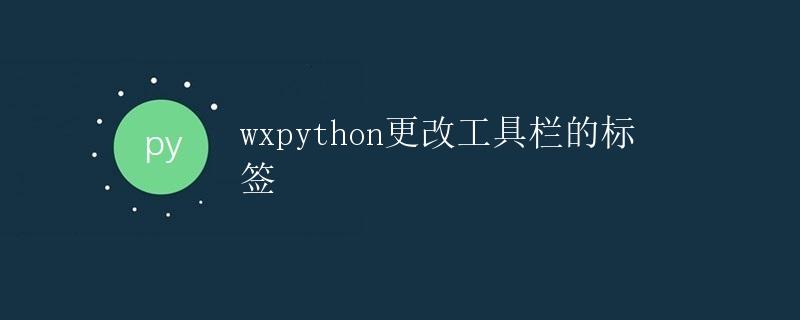wxPython更改工具栏的标签

在使用wxPython开发GUI应用程序时,工具栏(Toolbar)是一个常用的控件,用于提供用户操作的快捷方式。工具栏通常包含一系列工具按钮和标签,用于执行特定的功能或命令。在某些情况下,我们可能需要动态更改工具栏的标签,以响应用户的操作或实现一些特定的功能。本文将详细介绍如何使用wxPython实现更改工具栏的标签。
创建一个简单的工具栏
首先,我们需要创建一个简单的工具栏,包含几个工具按钮和标签。下面是一个基本的示例代码,演示如何创建一个包含两个工具按钮的工具栏:
import wx
class MyFrame(wx.Frame):
def __init__(self):
super().__init__(None, title="Toolbar Example", size=(400, 300))
self.toolbar = self.CreateToolBar()
self.toolbar.AddTool(wx.ID_ANY, "Button 1", wx.Bitmap(wx.ART_GO_FORWARD))
self.toolbar.AddTool(wx.ID_ANY, "Button 2", wx.Bitmap(wx.ART_GO_BACK))
self.toolbar.Realize()
self.Show()
if __name__ == "__main__":
app = wx.App()
frame = MyFrame()
app.MainLoop()
在这个示例中,我们创建了一个MyFrame类,继承自wx.Frame,并在初始化方法中创建了一个工具栏对象self.toolbar。然后我们使用AddTool方法向工具栏添加两个工具按钮,分别命名为”Button 1″和”Button 2″。最后调用Realize方法显示工具栏,并在主循环中运行应用程序。
更改工具栏的标签
接下来,我们将演示如何使用wxPython动态更改工具栏的标签。在实际应用中,我们可能需要根据用户的操作或程序的状态来更改工具栏中按钮的标签,以提供更好的用户体验。
下面是一个示例代码,演示如何在点击一个按钮时实现更改工具栏标签的功能:
import wx
class MyFrame(wx.Frame):
def __init__(self):
super().__init__(None, title="Toolbar Example", size=(400, 300))
self.toolbar = self.CreateToolBar()
self.button1_id = wx.ID_ANY
self.toolbar.AddTool(self.button1_id, "Button 1", wx.Bitmap(wx.ART_GO_FORWARD))
self.toolbar.AddTool(wx.ID_ANY, "Button 2", wx.Bitmap(wx.ART_GO_BACK))
self.toolbar.Bind(wx.EVT_TOOL, self.on_tool_click)
self.toolbar.Realize()
self.Show()
def on_tool_click(self, event):
if event.GetId() == self.button1_id:
button = self.toolbar.FindById(self.button1_id)
if button:
button.SetLabel("New Button Label")
self.toolbar.Realize()
if __name__ == "__main__":
app = wx.App()
frame = MyFrame()
app.MainLoop()
在这个示例中,我们给第一个按钮添加了一个ID,以便我们能够在事件处理方法on_tool_click中识别该按钮。在on_tool_click方法中,我们首先判断事件的ID是否与第一个按钮的ID相同,然后使用FindById方法找到该按钮并通过SetLabel方法更改其标签。最后调用Realize方法刷新工具栏,使更改生效。
进一步扩展
除了简单地更改工具栏的标签,我们还可以根据具体需求进行更复杂的操作,例如更改按钮的图标、绑定不同的事件等。下面是一个扩展示例代码,演示如何在点击按钮时切换标签,并根据标签不同执行不同的操作:
import wx
class MyFrame(wx.Frame):
def __init__(self):
super().__init__(None, title="Toolbar Example", size=(400, 300))
self.toolbar = self.CreateToolBar()
self.button1_id = wx.ID_ANY
self.button1_label = "Button 1"
self.is_button1_clicked = False
self.toolbar.AddTool(self.button1_id, self.button1_label, wx.Bitmap(wx.ART_GO_FORWARD))
self.toolbar.AddTool(wx.ID_ANY, "Button 2", wx.Bitmap(wx.ART_GO_BACK))
self.toolbar.Bind(wx.EVT_TOOL, self.on_tool_click)
self.toolbar.Realize()
self.Show()
def on_tool_click(self, event):
if event.GetId() == self.button1_id:
if self.is_button1_clicked:
self.button1_label = "Button 1"
self.toolbar.SetToolShortHelp(self.button1_id, "Click to Change Label")
else:
self.button1_label = "New Button Label"
self.toolbar.SetToolShortHelp(self.button1_id, "Click to Reset Label")
button = self.toolbar.FindById(self.button1_id)
if button:
button.SetLabel(self.button1_label)
self.toolbar.Realize()
self.is_button1_clicked = not self.is_button1_clicked
if __name__ == "__main__":
app = wx.App()
frame = MyFrame()
app.MainLoop()
在这个扩展示例中,我们使用一个布尔变量is_button1_clicked来表示按钮1是否被点击过。在每次点击按钮1时,我们根据按钮的点击状态切换标签,并相应地更改按钮的ShortHelp文本以提供提示信息。通过这种方式,我们可以根据按钮的状态来实现不同的功能效果,进一步提高用户体验。
通过以上示例,我们展示了如何使用wxPython实现更改工具栏的标签,以及进一步扩展功能的方法。在实际应用中,开发人员可以根据具体需求和设计理念,灵活运用工具栏的标签更改功能,实现更好的用户交互体验。
 极客教程
极客教程